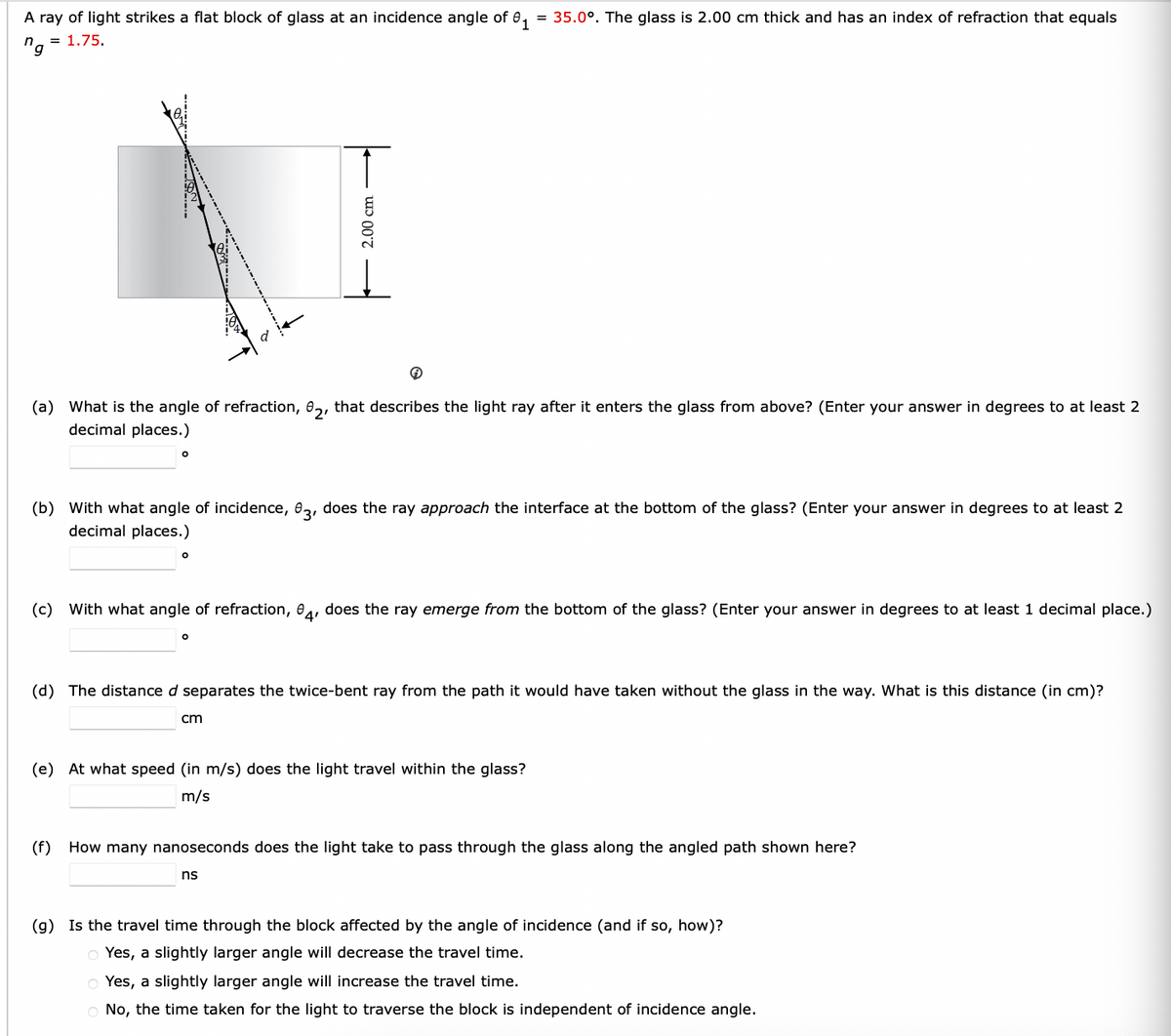A ray of light strikes a flat block of glass at an incidence angle of 01 = 35.0°. The glass is 2.00 cm thick and has an index of refraction that equals n = 1.75. 'g 2.00 cm (a) What is the angle of refraction, 2, that describes the light ray after it enters the glass from above? (Enter your answer in degrees to at least 2 decimal places.) (b) with what angle of incidence, 03, does the ray approach the interface at the bottom of the glass? (Enter your answer in degrees to at least 2 decimal places.) ° (c) with what angle of refraction, 84, does the ray emerge from the bottom of the glass? (Enter your answer in degrees to at least 1 decimal place.) о (d) The distance d separates the twice-bent ray from the path it would have taken without the glass in the way. What is this distance (in cm)? cm (e) At what speed (in m/s) does the light travel within the glass? m/s (f) How many nanoseconds does the light take to pass through the glass along the angled path shown here? ns (g) Is the travel time through the block affected by the angle of incidence (and if so, how)? Yes, a slightly larger angle will decrease the travel time. Yes, a slightly larger angle will increase the travel time. No, the time taken for the light to traverse the block is independent of incidence angle.
A ray of light strikes a flat block of glass at an incidence angle of 01 = 35.0°. The glass is 2.00 cm thick and has an index of refraction that equals n = 1.75. 'g 2.00 cm (a) What is the angle of refraction, 2, that describes the light ray after it enters the glass from above? (Enter your answer in degrees to at least 2 decimal places.) (b) with what angle of incidence, 03, does the ray approach the interface at the bottom of the glass? (Enter your answer in degrees to at least 2 decimal places.) ° (c) with what angle of refraction, 84, does the ray emerge from the bottom of the glass? (Enter your answer in degrees to at least 1 decimal place.) о (d) The distance d separates the twice-bent ray from the path it would have taken without the glass in the way. What is this distance (in cm)? cm (e) At what speed (in m/s) does the light travel within the glass? m/s (f) How many nanoseconds does the light take to pass through the glass along the angled path shown here? ns (g) Is the travel time through the block affected by the angle of incidence (and if so, how)? Yes, a slightly larger angle will decrease the travel time. Yes, a slightly larger angle will increase the travel time. No, the time taken for the light to traverse the block is independent of incidence angle.
Related questions
Question

Transcribed Image Text:A ray of light strikes a flat block of glass at an incidence angle of 01 = 35.0°. The glass is 2.00 cm thick and has an index of refraction that equals
n = 1.75.
'g
2.00 cm
(a) What is the angle of refraction, 2, that describes the light ray after it enters the glass from above? (Enter your answer in degrees to at least 2
decimal places.)
(b) with what angle of incidence, 03, does the ray approach the interface at the bottom of the glass? (Enter your answer in degrees to at least 2
decimal places.)
°
(c) with what angle of refraction, 84, does the ray emerge from the bottom of the glass? (Enter your answer in degrees to at least 1 decimal place.)
о
(d) The distance d separates the twice-bent ray from the path it would have taken without the glass in the way. What is this distance (in cm)?
cm
(e) At what speed (in m/s) does the light travel within the glass?
m/s
(f) How many nanoseconds does the light take to pass through the glass along the angled path shown here?
ns
(g) Is the travel time through the block affected by the angle of incidence (and if so, how)?
Yes, a slightly larger angle will decrease the travel time.
Yes, a slightly larger angle will increase the travel time.
No, the time taken for the light to traverse the block is independent of incidence angle.
Expert Solution
This question has been solved!
Explore an expertly crafted, step-by-step solution for a thorough understanding of key concepts.
This is a popular solution!
Trending now
This is a popular solution!
Step by step
Solved in 2 steps with 5 images
